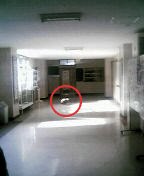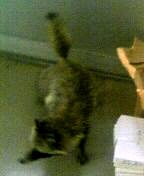When the evenings turn golden

A tanuki came into our school yesterday. Seriously. Right up to the second floor.
If my ancestors were Chinese, they would no doubt be totally mad at me right now for forgotting to blog the start of 清明, Seimei or "Pure Brightness", the calendar section that comes after Shunbun. It's known as "Pure Brightness" because of the quality of the light and the quantity of the blossoms.
The Chinese version of Seimei, Qingming, apparently starts with a festival known in English as Tomb-Sweeping Day. In Japan, though, there's no tomb-sweeping -- just flower-viewing! Which is code for "drinking near flowers".
As is usual in such matters, Seimei divides into three subseasons:
- 玄鳥至 -- Genchou Itaru, "Swallows ["mysterious birds"] arrive", i.e. back from down south where they spent the winter eating grits
- 鴻雁北 -- Kougan Kitasu, "Wild geese go north"
- 虹始見 -- Niji Hajimete Arawaru, "Rainbows are seen for the first time"
In the Chinese tradition, though, the first one is called 桐始華, which means "The paulownia begins to flower", and the second one is apparently 田鼠化為鶉, which seems to mean "voles turn into quails". Of course they do, of course they do.

You didn't believe me about the tanuki, did you? Today is also Hachiko Day. Hachiko was a dog who just didn't know when to quit: he waited for his master at Shibuya station every day, even after his master died -- although, as Wikipedia points out, it probably didn't hurt his faithfulness any that people would give him food there.
Then they erected a statue of him (then melted it down for the war effort, then erected another later) so that he can wait there forever. Forever and ever and ever. Seriously -- doesn't that seem kind of sad? At least erect a statue of his master too or something.
Ironically, the Hachiko statue is such a popular place to meet that it's no longer effective as a meeting place. The crowd there is so thick that even after you arrive you have to call your friends and ask exactly where in the Hachiko throng they are.
No, my friends, far better to meet at the terrifying head around the corner, known as the Shibuya Moyai-zou, which is half-named after the moai monuments on Easter island and half-named after a word in Niijima dialect, moyai, meaning "to work together". (The statue itself was a gift from Niijima to Tokyo commemorating 100 years of being under Tokyo's administrative supervision.)
Incidentally, the English Wikipedia entry for Niijima is, at present, the cutest Wikipedia entry ever, and I am going to preserve it here for posterity because no doubt some hard-hearted person will eventually replace it with a more standard encyclopedia-style version.
Niijima (新島) is 25km² in area. Its population is 3000. Its takes about 2 hours by Jet boat and 9 hours by ship from Tokyo. Niijima has many very, very beautiful beaches. We can surf on Habushi beach, which is famous for its big waves and white sand. Niijima specialties are a dried fish called kusaya, milk senbei and a plant called ashitaba. There are 3 hot springs on Niijima. We recommend the outdoor hot spring. It's free and open 24 hours. The water here is salty because it wells out from the sea. When you use this hot spring, you must wear a swimsuit. Koga stone is another specialty on Niijima. We can make glass from it. Niijima glass is a transparent green colour. We can make Moyai art, for example, animal art, from Koga stone. There is a zoo of animal art on Niijima. Niijima museum shows the history of the island. We can see a big boat, an old house and we can watch a video about how to make kusaya there. There is also a bowling alley, table tennis and a free bath on Niijima. Many ebine flowers are planted in Ebine park. Ebine is a pink or purple lily. The park is open in early spring. Niijima farm has 2 horses, many pigs, rabbits and chickens. We can ride on the horses. Please come to Niijima because the sea is beautiful, you can have a good time and there are many wonderful things to do.
(Written by Niijima High School juniors, February 2005).
![[No-sword]](http://no-sword.jp/images/site/no-sword_banner.jpg)



Eric:
Dammit. Everytime I type in "no-sword.jp" I want to type in "no-sword.jpg."
I blame you, M. Matt.